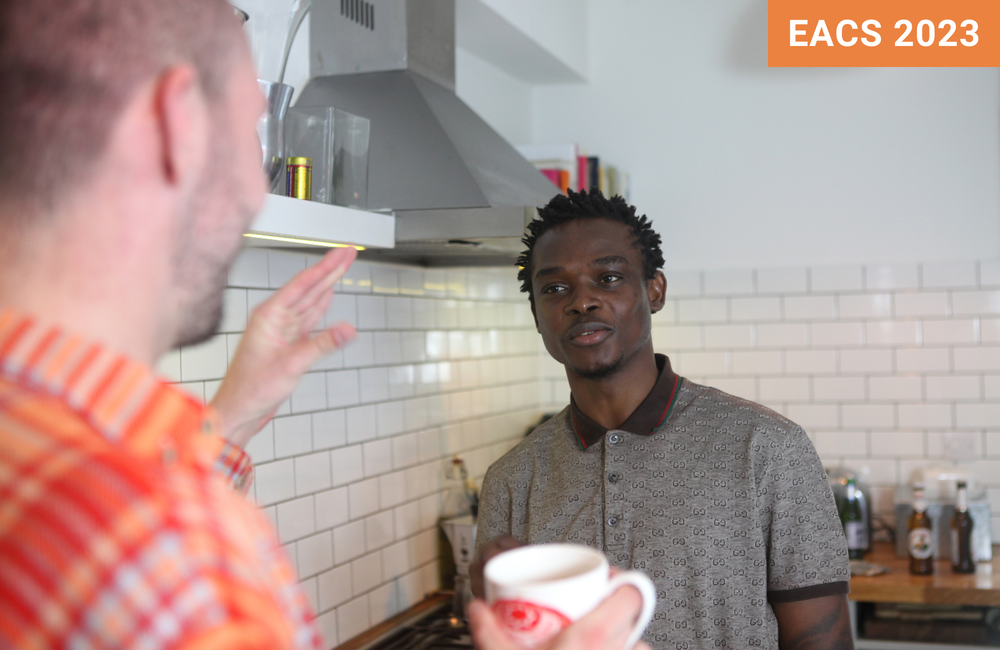
A study of foreign-born gay and bisexual men living with HIV in France has concluded that 62% of them acquired HIV after moving to the country. The study was presented at the 19th European AIDS Conference (EACS 2023) in Warsaw, Poland.
Men from north Africa and Asia were more likely than men from elsewhere in the world to acquire HIV in France, and men from South America less likely. Asian and sub-Saharan Africans were particularly likely, compared with others, to acquire HIV within their first year of arrival.
The GANYMEDE study looked at 1159 gay and bisexual men with HIV who attended 14 care centres in the Paris region. Their average age now was 43, they had been in France for an average of 18 years, and had been in HIV care for six years.
Twenty-nine per cent were from South America, 21% from other European countries, 16% from north Africa, 15.5% from sub-Saharan Africa, 15% from Asia or Oceania and 3% from North America.
Their average CD4 count at diagnosis was 400, indicating fairly recent infection, though 5.4% had an AIDS-defining illness at diagnosis. The 14.5% of study participants who had a viral load below 50 when they arrived in France were presumed to have acquired HIV before arrival.
The challenges facing some immigrants were illustrated by the results of a survey of the participants. Just under 50% said they could not speak French on arrival; nearly 25% arrived as asylum seekers or undocumented migrants; 28% had no medical coverage of any kind; 8% were homeless in their first year in France; 27% were unemployed; and over half described not having enough money.
In terms of why they had come to France, 37% gave study as their main reason (just over half had arrived on a student visa), but nearly as many (35%) said avoiding persecution for their sexuality was the most important reason. Only 10% gave medical necessity as the main reason, but of these the majority (64%) said getting HIV treatment was the reason.
About half of the participants could pinpoint fairly accurately when they acquired HIV; the date of infection for the other half was established from medical records or estimated using their last CD4 count before starting antiretroviral therapy as an indicator.
The researchers estimated that 62% of study participants had acquired HIV after arriving in France. This varied substantially with their region or origin; a large majority of north Africans (85%) and people from Asia and Oceania (73%) acquired HIV in France but only a minority (40%) of men from South America – largely reflecting HIV prevalence among gay and bisexual men in their home country.
For most migrant men who arrived without HIV, the chance of acquiring it in their first year was considerably higher than in subsequent years. Their chance of acquiring HIV in their first year was 13%, compared with an average of 5.5% per year in the following four years and 4.8% per year in the next five.
First-year infection was particularly common in sub-Saharan Africans. An estimated 25% of those who acquired HIV in France did so in their first year there, compared to only 4.6% per year in the next four years and 3.9% in years six to ten. Similarly, for Asian men, 16% acquired HIV in their first year compared with 6% in any of the following nine years. Eleven per cent of north Africans acquired HIV in their first year, 5.7% in years two to five and 3.4% in years six to ten but nearly half acquired HIV after having been in France for eleven years or more, and although annual rates cannot be estimated beyond year ten, the risk of HIV did seem to increase again after that time.
In contrast, arrivals from other European countries had a more-or-less even chance of acquiring HIV in any of their first ten years in France, from 6.6% in their first year to 5.4% in years six to ten, while for the small number of north Americans, the risk seemed to rise over time, with 5.8% acquiring HIV in their first year but 8.5% per year in years six to ten.
In multivariate analysis, sub-Saharan African men had ten times the odds of acquiring HIV in their first year of arrival than Europeans, and Asians five times. Although men over 30 were less likely to acquire HIV in France than younger men (because a higher proportion already had it), their likelihood of acquiring it in their first year was 12% higher than for younger men. Men who had more than ten sexual partners in their first year were 7.6 times more likely to acquire HIV in that year than men who had fewer. Men scoring high for social deprivation indicators such as homelessness or unemployment were 2.5 times more likely.
The researchers comment: “This increased risk may be explained by the accumulation of vulnerability factors and changes in sexual behaviour, particularly as a result of a more permissive environment to have gay sex.”
Palich R et al. High proportion of post-migration HIV acquisition in foreign-born men who have sex with men receiving HIV care in France, and association with precariousness and sexual behaviour: results of the ANRS-MIE GANYMEDE study. 19th European AIDS Conference, Warsaw, poster P.C1.035, 2023.
